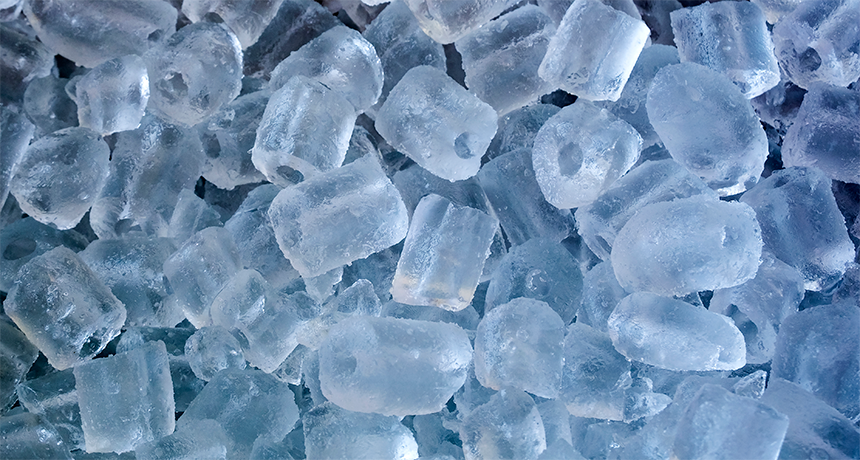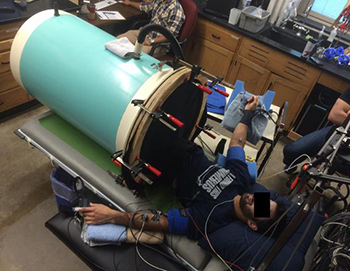Adding ice to medics’ kits could help patients survive blood loss
Cooling the face may save lives by keeping blood pressure up

Medics may have a new tool to help severely injured patients: ice. A bag of it on the face could help to keep blood pressure up in those suffering severe blood loss.
mumemories/iStockphoto
Keeping a cool attitude helps when handling an accident victim who has lost a large amount of blood. But keeping patients cool might also help, a new study finds. It might save their lives.
Here’s why: Losing a lot of blood can lead to a dangerous loss of blood pressure. That can limit how much blood, and therefore oxygen, reaches the brain and other vital organs. If deprived of enough oxygen, those tissues — and the patient — could die.
The body doesn’t have to spill most of its blood for this to happen. Losing about 2 liters (a half gallon) out of the 5 liters (1.3 gallons) or so in the body could be fatal. In fact, most deaths among army troops are due to excess blood loss — even if the inflicted wounds do not directly affect a vital organ, says Victor Convertino. A physiologist, he studies body functions at a research institute of the U.S. Army in Houston, Texas. He was not involved in this study.
Convertino thinks medics and others can save some lives if they can maintain adequate blood pressure — and thereby blood flow — to vital tissues until the victim reaches the hospital. (Vital tissues include the heart and brain.) Once there, blood transfusions can take over.
Blair Johnson may have found a way to achieve this. He is a physiologist at the University of Buffalo in New York. There, he focuses on developing effective ways to maintain blood pressure in the body after potentially catastrophic blood loss. He described a potential new first-aid approach to cope with such situations, April 26, at the Experimental Biology meeting in Chicago, Ill. His idea is simple: Just cool the victim’s face.
The concept
Johnson drew inspiration from the body’s natural response to a drop in the supply of oxygen to its tissues. Consider when you dive into a swimming pool. The body abides by a simple rule: When in crisis, save the vital organs. So, while underwater, the body turns on a so-called “diving reflex.” It directs to the brain and heart what limited oxygen is available. “Your blood pressure goes up, and your heart rate falls down, especially if the water is cold,” Johnson explains.
Think of blood vessels as a system of fluid-filled tubes. When the body is exposed to cold water, these tubes narrow. If the fluid volume stays the same, the overall pressure in the system increases.
Cooling the entire body of an accident victim is impractical. But cooling just the face should be possible, says Convertino — even when dealing with injuries on the battlefield.

To test the idea, Johnson’s group recruited 10 people to take part in an experiment. None had to actually lose blood. Instead, the scientists tricked their bodies into believing that they had. To do this, they sealed each person’s body from the waist down in a chamber. Then a vacuum sucked air out of the chamber. This dropped the pressure inside. Blood rushed to the lower body of the volunteers because of the pressure difference between the chamber and rest of the room. This mimics how the body reacts to losing about 1 liter (0.3 gallon) of blood.
While the machine simulated blood loss, the researchers treated the recruits’ faces. They placed a bag containing a mix of either ice and water or just water onto the forehead and over the eyes. Placing the cold ice-water bag on the face of volunteers for 15 minutes increased blood pressure, the scientists found. In fact, it pushed blood pressure close to normal. This treatment also decreased the volunteers’ heart rate. Placing a bag of only water on the face of volunteers, though, did not affect their blood pressure and heart rate.
This face-cooling treatment is not a long-term fix, Convertino cautions. It is likely to help most when a hospital can be reached within 15 minutes. “If it gets past 30 to 60 minutes, it may not be so practical,” he says. After that time, the tissues may begin experiencing too much oxygen loss and die.







